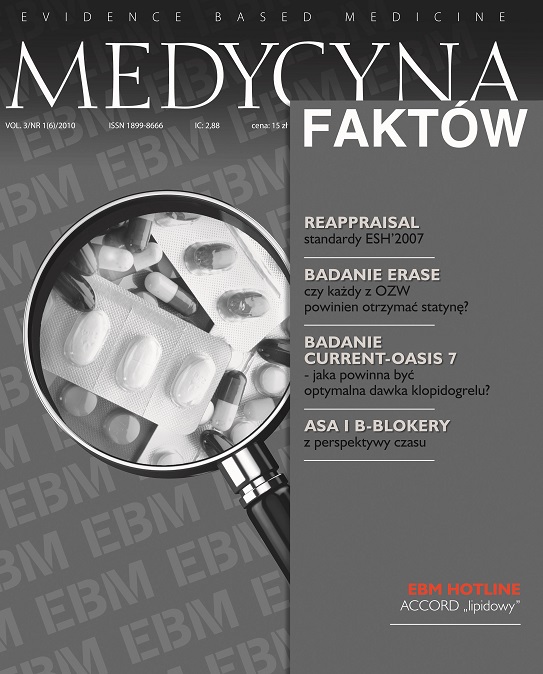Badanie ERASE – czy każdy pacjent z ostrym zespołem wieńcowym powinien otrzymać statynę? Efekty działania inhibitorów HMG-CoA na blaszkę miażdżycową w ostrym zespole wieńcowym Artykuł przeglądowy
##plugins.themes.bootstrap3.article.main##
Abstrakt
Korzystne efekty działania statyn w redukcji zgonów i zawałów serca potwierdzono zarówno u pacjentów ze stabilną dusznicą bolesną, jak i u pacjentów z ostrym zespołem wieńcowym. W badaniach z wykorzystaniem ultrasonografii wewnątrznaczyniowej wykazano, że intensywna terapia statynami powoduje zmniejszenie objętości blaszki miażdżycowej niezależnie od wyjściowego poziomu cholesterolu. W 2009 r. ukazała się analiza badania ERASE, gdzie zaobserwowano zmniejszenie objętości blaszki miażdżycowej u pacjentów z ostrym zespołem wieńcowym już 6 tygodni ±1 od wdrożenia leczenia statynami. Pomimo ograniczeń ww. analizy wyniki badania ERASE potwierdzają słuszność stosowania terapii inhibitorami HMG-CoA jak najszybciej po epizodzie OZW.
##plugins.themes.bootstrap3.article.details##
Copyright © by Medical Education. All rights reserved.
Bibliografia
2. Long-Term Intervention with Pravastatin in Ischemic Disease (LIPID) Study Group: Prevention of cardiovascular events and death with pravastatin in patients with coronary heart disease and a broad range of initial cholesterol levels. N. Engl. J. Med. 1998; 339: 1349-1357.
3. Goldberg R.B., Mellies M.J., Sacks F.M. et al.: Cardiovascular events and their reduction with pravastatin in diabetic and glucose-intolerant myocardial infarction survivors with average cholesterol levels: subgroup analysis in the cholesterol and recurrent events (CARE) trial: the CARE Investigators. Circulation 1998; 98: 2513-2519.
4. Heart Protection Study Collaborative Group: MRC/BHF Heart Protection Study of cholesterol-lowering with simvastatin in 5963 people with diabetes: a randomised placebo-controlled trial. Lancet 2003; 361: 2005-2016.
5. Nissen S.E.: Halting the progression of atherosclerosis with intensive lipid lowering: results from the Reversal of Atherosclerosis With Aggressive Lipid Lowering (REVERSAL) trial. Am. J. Med. 2005; 118: 22S-27S.
6. Nissen S.E., Nicholls S.J., Sipahi I. et al.: Effect of very high-intensity statin therapy on regression of coronary atherosclerosis: the ASTEROID trial. JAMA 2006; 295: 1556-1565.
7. Okazaki S., Yokoyama T., Miyauchi K. et al.: Early Statin Treatment in Patients With Acute Coronary Syndrome: Demonstration of the Beneficial Effect on Atherosclerotic Lesions by Serial Volumetric Intravascular Ultrasound Analysis During Half a Year After Coronary Event: The ESTABLISH Study. Circulation 2004; 110: 1061-1068.
8. Hiro T., Kimura T., Morimoto T. et al.: Effect of Intensive Statin Therapy on Regression of Coronary Atherosclerosis in Patients With Acute Coronary Syndrome A Multicenter Randomized Trial Evaluated by Volumetric Intravascular Ultrasound Using Pitavastatin Versus Atorvastatin (JAPAN-ACS [Japan Assessment of Pitavastatin and Atorvastatin in Acute Coronary Syndrome] Study). J. Am. Coll. Cardiol. 2009; 54: 293-302.
9. Rodés-Cabau J., Tardif J.C., Cossette M. et al.: Acute Effects of Statin Therapy on Coronary Atherosclerosis Following an Acute Coronary Syndrome. Am. J. Cardiol. 2009; 104: 750-757.
10. Schwartz G.G., Olsson A.G., Ezekowitz M.D. et al.: Effects of atorvastatin on early recurrent ischemic events in acute coronary syndromes: the MIRACL study: a randomized controlled trial. JAMA 2001; 285: 1711-1718.
11. Ray K.K., Cannon C.P., McCabe C.H. et al.: Early and late benefits of high-dose atorvastatin in patients with acute coronary syndromes: result from the PROVE IT – TIMI 22 trial. J. Am. Coll. Cardiol. 2005; 46: 405-410.
12. Cannon C.P., Braunwald E., McCabe C.H. et al.: Intensive versus moderate lipid lowering with statins after acute coronary syndromes. N. Engl. J. Med. 2004; 350: 1495-1504.
13. de Lemos J.A., Blazing M.A., Wiviott S.D. et al.: Early intensive vs a delayed conservative simvastatin strategy in patients with acute coronary syndromes: phase Z of the A to Z trial. JAMA 2004; 292: 1307-1316.
14. Crisby M., Nordin-Fredriksson G., Shah P.K. et al.: Pravastatin treatment increases collagen content and decreases lipid content, inflammation, metalloproteinases, and cell death in human carotid plaques: implications for plaque stabilization. Circulation 2001; 103: 926-933.
15. Kinlay S., Rifai N., Libby P., Ganz P.: Effect of atorvastatin on C-reactive protein in patient with acute coronary syndrome: a substudy of the MIRACL Trial. J. Am. Coll. Cardiol. 2002; 39 (Suppl A): 304A.
